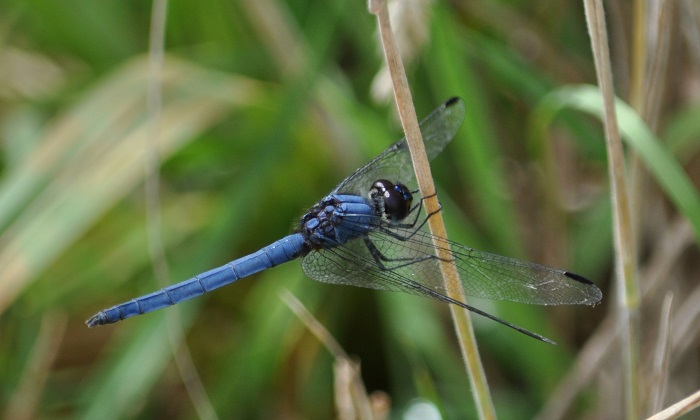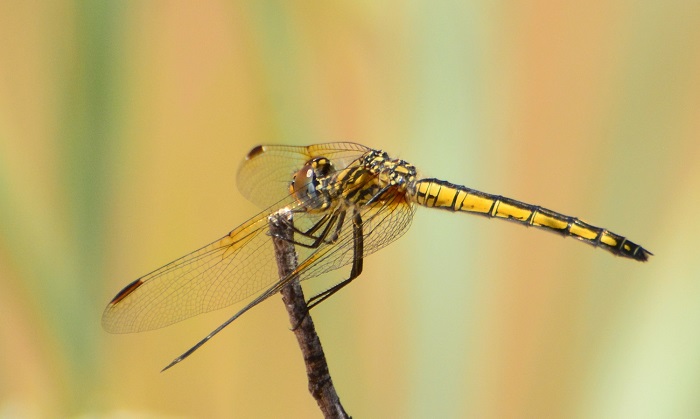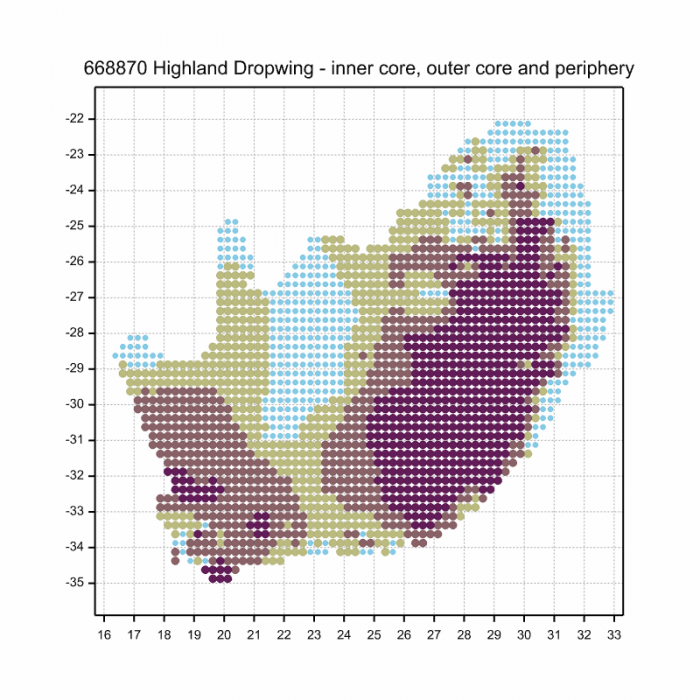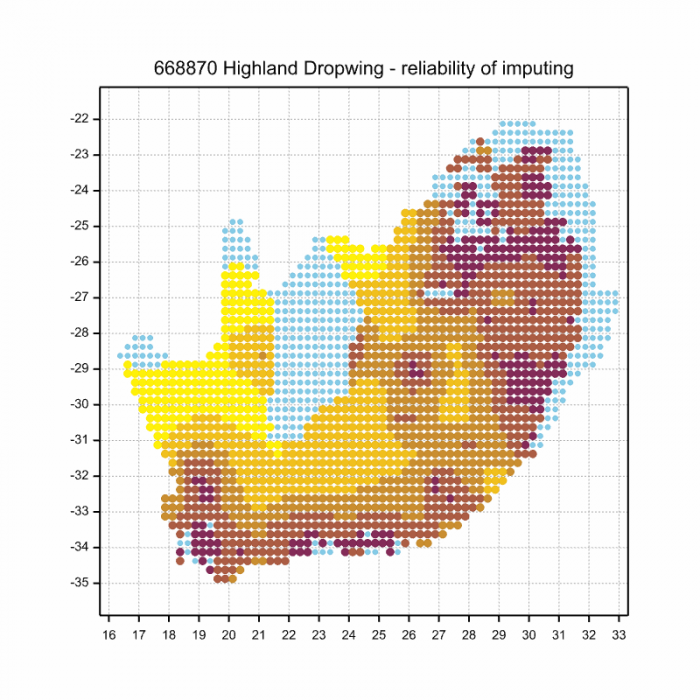The photo above (by Alan Manson) can be viewed in OdonataMAP here.
Find this species in the FBIS database (Freshwater Biodiversity Information System) here.
Family Libellulidae
Identification

Elands River, KwaZulu-Natal
Photo by Ryan Tippett
Small to medium size
Length up to 40mm; Wingspan attains 65mm.
The Highland Dropwing is most likely to be confused with the very similar Navy Dropwing (Trithemis furva). Males of the two are best identified in the hand by examining the shape of the secondary genitalia. The males can also (mostly) be told apart by checking the last Ax vein in the front wings. In Trithemis furva the last Ax vein extends as far as the subcostal vein and does not reach the radial vein. Trithemis dorsalis shows Ax veins that cross the subcostal vein to meet up with the radial vein.
In addition, the two species can be tentatively identified based on their preferred habitat choice. Although they co-occur at many sites, the Highland Dropwing is far more numerous than the navy dropwing at higher altitudes.
The Denim Dropwing (Trithemis donaldsoni) is also similar but is larger and distinctly paler in colour.
The Female Highland Dropwing is readily identified by the narrow, wavy black stripes on the sides of the thorax.
Click here for more details on identification of the Highland Dropwing.

Lake Naverone, KwaZulu-Natal
Photo by Ryan Tippett
Habitat
The Highland Dropwing inhabits the fringes of rivers, streams and dams. It prefers slow moving sections of rivers and is far less regular along fast flowing stretches. Highland Dropwings are common along the vegetated fringes of dams that are lined with reeds, grasses, and sedges.

Photo by Rowan Poortier
Behaviour
The Highland Dropwing is a conspicuous species that perches openly on emergent or fringing vegetation. At rest, it sits with its wings drooped downwards in typical ‘dropwing’ fashion. The Highland Dropwing is most common above 700m above sea level, but is regular at lower altitudes in the Western Cape.
The Highland Dropwing is on the wing from October to May.

Lake Naverone, KwaZulu-Natal
Photo by Ryan Tippett
Status and Conservation
In South Africa, the Highland Dropwing is common, particularly in higher-altitude areas. It is listed as of Least Concern in the IUCN Red List of Threatened Species. The Highland Dropwing readily makes use of man-made and degraded habitats.

Gifberg, Western Cape
Photo by Ryan Tippett
Distribution
The Highland Dropwing is locally distributed across the highland regions of eastern and southern Africa. It is found in Angola, the Democratic Republic of the Congo, Guinea, Kenya, Mozambique, Sierra Leone, South Africa, Tanzania, Uganda, Zambia, Zimbabwe, and possibly also Burundi and Malawi.
In South Africa Trithemis dorsalis is predominantly a species of the Drakensberg and Highveld, but is widespread in mid to high altitude regions, from the south-western Cape to northern Limpopo.

Seweweekspoort, Western Cape
Photo by Ryan Tippett
Below is a map showing the distribution of records for Highland Dropwing in the OdonataMAP database as at February 2020.

Below is a map showing the distribution of records for Highland Dropwing in the OdonataMAP database as of December 2024.

The next map below is an imputed map, produced by an interpolation algorithm, which attempts to generate a full distribution map from the partial information in the map above. This map will be improved by the submission of records to the OdonataMAP section of the Virtual Museum.


Ultimately, we will produce a series of maps for all the odonata species in the region. The current algorithm is a new algorithm. The objective is mainly to produce “smoothed” maps that could go into a field guide for odonata. This basic version of the algorithm (as mapped above) does not make use of “explanatory variables” (e.g. altitude, terrain roughness, presence of freshwater — we will be producing maps that take these variables into account soon). Currently, it only makes use of the OdonataMAP records for the species being mapped, as well as all the other records of all other species. The basic maps are “optimistic” and will generally show ranges to be larger than what they probably are.
These maps use the data in the OdonataMAP section of the Virtual Museum, and also the database assembled by the previous JRS funded project, which was led by Professor Michael Samways and Dr KD Dijkstra.

Wilge River, Free State
Photo by Ryan Tippett
Further Resources
The use of photographs by Alan Manson and Rowan Poortier is acknowledged. All other photographs by Ryan Tippett.
Highland Dropwing Trithemis dorsalis (Rambur, 1842)
Other common names: Dorsal Dropwing (Alt. English); Hooglandvalvlerkie (Afrikaans
Recommended citation format: Loftie-Eaton M; Navarro R; Tippett RM; Underhill L. 2025. Highland Dropwing Trithemis dorsalis. Biodiversity and Development Institute. Available online at https://thebdi.org/2020/05/08/highland-dropwing-trithemis-dorsalis/
References: Tarboton, M; Tarboton, W. (2019). A Guide to the Dragonflies & Damselflies of South Africa. Struik Nature.
Samways, MJ. (2008). Dragonflies and Damselflies of South Africa. Pensoft
Samways, MJ. (2016). Manual of Freshwater Assessment for South Africa: Dragonfly Biotic Index. Suricata 2. South African National Biodiversity Institute, Pretoria
Martens, A; Suhling, F. (2007). Dragonflies and Damselflies of Namibia. Gamsberg Macmillan.

Wilge River, Free State
Photo by Ryan Tippett

